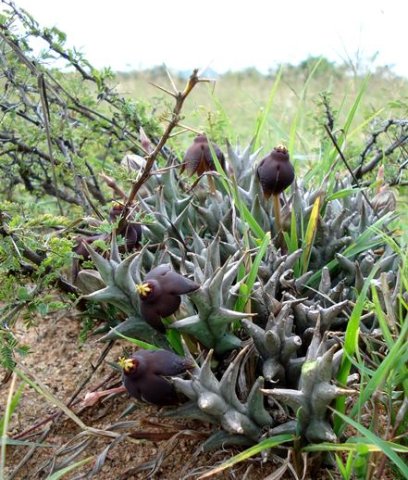Orbea

Author: Ivan Lätti
Photographer: Judd Kirkel Welwitch
Orbea is a genus of dwarf stem succulents in the Apocynaceae family. The often-rhizomatous plants branch from the base into erect or prostrate stems.
The angled stems are acutely toothed along the four stem ridges. The teeth are cone-shaped or triangular, spreading their soft tips initially topped by short-lived, rudimentary leaves. There are usually two stipules, even smaller and also tooth-like, present near the tooth tips.
One to a few inflorescences grow from a stem base, comprising one to forty flowers that usually open in succession. The sometimes faintly smelly flowers often spread on the ground. The flowers differ in size from 1 cm to 10 cm.
The actinomorphic flowers have free petals without tubes, otherwise bell-shaped. There is often a thickened part below the petal lobe bases, forming a prominent ring or annulus. The generic name, Orbea, is derived from the Latin word orbis meaning circle, referring to this thickened corolla annulus.
The outside of the flower is smooth, often streaked purple, the inside smooth or finely wrinkled. The lobes or petals spread or are reflexed and about flat on top, sometimes with club-shaped marginal protrusions capable of vibrating and forming fringes. This movement may attract pollinators.
The inner flower part, the corona on a short stalk comprises ten smooth lobes alternating in two series, the inner and outer coronas. The five outer corona lobes spread or may be erect under the anther wings and above the nectaries. The five inner corona lobes are erect in the centre, coming together at the top, the backs of the anthers pressed to them. The anthers are horizontal on top of the style head. The pollinia are ovate to nearly circular.
The fruits are hairless, spindle-shaped to cylindrical follicles. These follicles contain numerous seeds with silken-haired attachments facilitating flight in dispersal.
There are 20 Orbea species, 18 of which occur in southern Africa. This genus has undergone comparatively many changes in the botanical rearrangement involving understanding of the family structure. Early in the twentieth century most Orbea species were still included in Stapelia and Caralluma respectively.
The plant in picture is the Zimbabwean species, Orbea umbracula (Leistner, (Ed.), 2000; White and Sloane (1937); www.asclepiad-exhibition.org; http://pza.sanbi.org).

